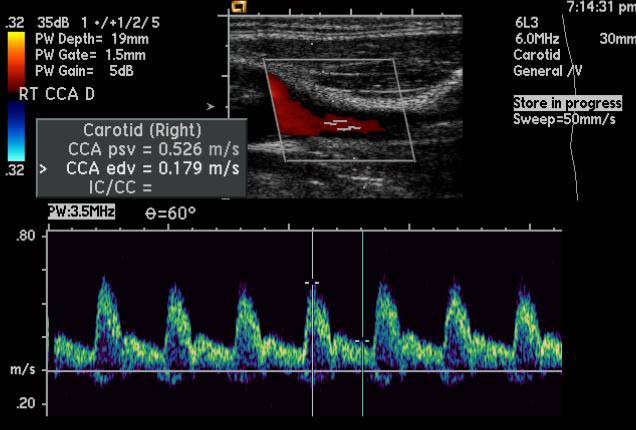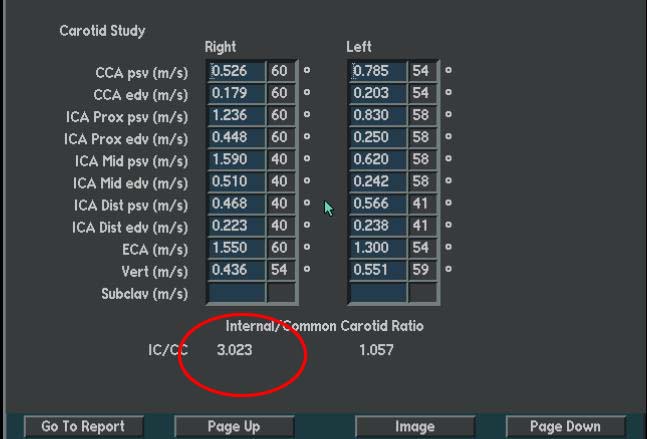Carotid artery stenosis
For patient information, click here
| Carotid artery stenosis | |
 | |
|---|---|
| ICD-10 | I65.2 |
| ICD-9 | 433.1 |
| DiseasesDB | 31178 |
| MeSH | D016893 |
Editor-In-Chief: C. Michael Gibson, M.S., M.D. [1]; Associate Editor-In-Chief: Cafer Zorkun, M.D., Ph.D. [2]
Overview
Carotid arterial stenosis is a narrowing of the lumen of the carotid artery, usually by atheroma (a fatty lump or plaque causingatherosclerosis). Atheroma's may cause transient ischemic attacks (TIAs) and cerebrovascular accidents (CVAs) as it obstructs the bloodstream to the brain. It also has the potential to generate emboli (blood clots) that obstruct the cerebral arteries.
The narrowing can either be asymptomatic (causing no medical problems) or presents with symptoms such as TIAs and CVAs.
Diagnosis
Carotid stenosis is usually diagnosed by ultrasound scan of the neck arteries. This is the first imaging option and usually used for follow up and observation as it involves no radiation and no contrast agents that may cause allergic reactions.
If there is doubt whether the narrowing is still patent (open to blood flow) and the patient is to be assessed for treatment, the next imaging option would either be computed tomography angiogram (CTA) or a magnetic resonance imaging angiogram (MRA).
CTA is usually used as it's more widely available and faster (takes only several minutes). However, it does involve significant X-ray radiation and the use of contrast agents which is usually iodinated, which can cause allergic reactions, even anaphylaxis and can also cause renal failure.
MRA takes much longer to complete, more costly and not yet as widely available.
Ultrasound Criteria for Carotid Artery Stenosis
- Normal:
- ICA PSV is less than 125 cm/sec and no plaque or intimal thickening is visible sonographically.
- Additional criteria include ICA/CCA PSV ratio < 2.0 and ICA EDV < 40 cm/sec.
- <50% ICA stenosis:
- ICA PSV is less than 125 cm/sec and plaque or intimal thickening is visible sonographically.
- Additional criteria include ICA/CCA PSV ratio < 2.0 and ICA EDV < 40 cm/sec.
- 50%–69% ICA stenosis:
- ICA PSV is 125–230 cm/sec and plaque is visible sonographically.
- Additional criteria include ICA/CCA PSV ratio of 2.0–4.0 and ICA EDV of 40–100 cm/sec.
- >=70% ICA stenosis but less than near occlusion
- ICA PSV is greater than 230 cm/sec and visible plaque and luminal narrowing are seen at gray-scale and color Doppler US (The higher the Doppler parameter lies above the threshold of 230 cm/sec, the greater the likelihood of severe disease).
- Additional criteria include ICA/CCA PSV ratio > 4 and ICA EDV > 100 cm/sec.
- Vear occlusion of the ICA:
- Velocity parameters may not apply, since velocities may be high, low, or undetectable.
- Diagnosis is established primarily by demonstrating a markedly narrowed lumen at color or power Doppler US (35).
- Total occlusion of the ICA
- No detectable patent lumen at gray-scale US and no flow with spectral, power, and color Doppler US. [1]
Treatment
Options for treatment include:
- Conservative: Antiplatelet drug
- Carotid endarterectomy (surgical removal of the atheroma)
- Carotid stenting
Examples
{{#ev:youtube|nkCmbY_oLAo}}
See also
References
- ↑ Edward G. Grant, Carol B. Benson, Gregory L. Moneta, Andrei V. Alexandrov, J. Dennis Baker, Edward I. Bluth, Barbara A. Carroll, Michael Eliasziw, John Gocke, Barbara S. Hertzberg, Sandra Katanick, Laurence Needleman, John Pellerito, Joseph F. Polak, Kenneth S. Rholl, Douglas L. Wooster, and Eugene Zierler. Carotid Artery Stenosis: Gray-Scale and Doppler US Diagnosis—Society of Radiologists in Ultrasound Consensus Conference. Radiology published online September 18, 2003.

